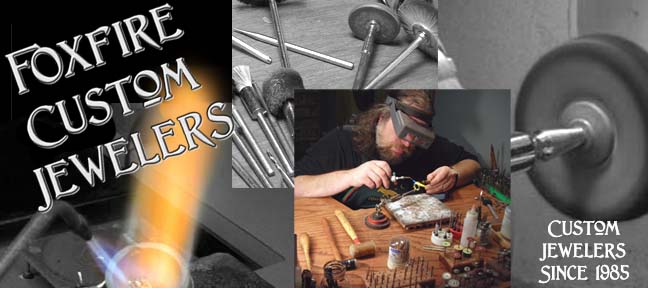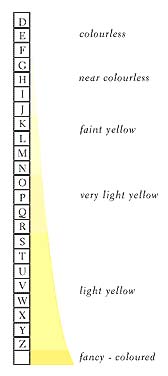
 Diamonds:
Diamonds:The Enduring Gift of Love
For centuries, men and women have found
that the sparkle and brilliance of a quality diamond expresses their
deepest emotions and symbolizes their enduring love. Yet with many
beautiful diamonds to choose from - and no two alike - how do you pick
the right diamond while spending wisely? The 4Cs, along with the
guidance of a trusted jeweler such as Foxfire Jewelers, will lead you
to the answer.
To establish a diamond's quality, jewelers examine each of the 4Cs - cut, clarity, carat weight and color. The combination of the 4Cs determines the value of a particular diamond. For example, a colorless diamond is at the top of the Diamond Quality Hierarchy in color ... but if it lacks clarity, is small, or not well cut, it will be of a lower beauty and therefore, value. The most beautiful diamonds are those with superior cutting to show the greatest sparkle, good clarity so as not to detract from the overall look, excellent color to appear white as ice and snow, and size enough to make you proud.
We can help find a diamond that's right for you. Our personal service will help guide you through the choices in a way that feels comfortable and relaxed. Buying a diamond should be an enjoyable experience, not a daunting task or a battle of wills with the salesperson. We promise no pressure, ever, and we never work on commission.
The Diamonds we carry are all certified Conflict Free, subject to the Kimberly Process, so you may rest assured they do not promote bad activities.
Foxfire Jewelers is also proud to announce that we have found a supplier of Ideal Cut Diamonds in smaller sizes so even our multi diamond pieces and side stones can be amazing, with the superior sparkle and brilliance that makes diamonds so beautiful.
We will give you all the education you need, because we make it our business to know alot about diamonds. Knowing a diamond's place in the Diamond Quality Hierarchy will help you to make an informed decision. Ultimately, you'll discover the unique combination of the characteristics that makes a particular diamond the right choice for you. Its beauty and brilliance will capture the true sentiment of the occasion.
How to Measure a Diamond's Value
The Four C's are a framework to help you compare diamonds. While all diamonds are precious, those of the highest quality - possessing the best combination of Cut, Clarity, Carat weight and Color - are the earth's rarest, most valuable and most beautiful to the eye.
CARAT

The Larger a Diamond, the More Rare
Larger diamonds are found relatively infrequently in nature, which places them at the rarest level of the Diamond hierarchy. What also makes a bigger diamond so desirable is that it shows off a stone's fine color and cut, and therefore its brilliance, to its best advantage.
A diamond's size is measured in carat weight, and each carat is equal to 100 points. A .75 carat diamond is the same as a 75-point diamond or a 3/4 carat stone.
While larger diamonds are highly prized, diamonds of equal size may vary widely in value and brilliance, depending on their qualities of clarity, cut, and color.
CLARITY
The Purer a Diamond, the More Brilliant
The greater a diamond's clarity, the more brilliant, valuable and rare it is - and the higher it is on the Diamond Quality Hierarchy.
Virtually all natural diamonds contain identifying characteristics, yet many are invisible to the naked eye. Under the scrutiny of a jeweler's 10x-magnifying loupe or microscope, natural phenomena - called inclusions - may be seen. These are nature's birthmarks, and they may look like tiny crystals, clouds, or feathers.
Diamonds categorized as internally flawless reveal no such inclusions. Flawless stones are at the peak of the Diamond Quality Hierarchy and are treasured for their rarity and beauty. Diamonds with very, very small inclusions are graded as VVS1 or VVS2. The larger the inclusion, the lower the grade and the less rare the diamond. Inclusions that can be seen with the naked eye are graded I1 or I3.
The number, color, type, size and position of surface and internal birthmarks affect a diamond's value. Major inclusions can interfere with the path of light that travels through a diamond, diminishing its brilliance and sparkle and therefore its value.
COLOR
 The More
Pure the Color in a Diamond, the More Rare
The More
Pure the Color in a Diamond, the More Rare
Diamonds are graded by color, starting at D and continuing through the alphabet. Truly colorless stones, graded D, treasured for their rarity and value, are highest on the Diamond Quality Hierarchy.
While many diamonds appear colorless, they may actually have subtle yellow or brown tones and these color grades include P and Q. Although still beautiful, they will be less rare and therefore less valuable. To appreciate the simple beauty of each individual stone, you should compare diamonds side by side with a jeweler.
"Fancy" diamonds - in well defined colors that include red, pink, blue, green and canary yellow - are highly prized and particularly rare.
CUT
The Better Cut a Diamond, the More Brilliant
A well cut or faceted diamond, regardless of its shape, scintillates with fire and light - offering the greatest brilliance and value.
While nature determines a diamond's clarity, carat weight and color, the hand of a master craftsman is necessary to release its fire, sparkle and beauty. When a diamond is cut to good proportions, light will reflect from one mirror-like facet to another and disperse through the top of the stone, resulting in a display of brilliance and fire.

Diamonds that are cut too deep or too shallow lose light that spills through the side or bottom. As a result, poorly cut stones will be less brilliant and beautiful - and certainly less valuable - than well cut diamonds higher on the Diamond Quality Hierarchy.
To establish a diamond's quality, jewelers examine each of the 4Cs - cut, clarity, carat weight and color. The combination of the 4Cs determines the value of a particular diamond. For example, a colorless diamond is at the top of the Diamond Quality Hierarchy in color ... but if it lacks clarity, is small, or not well cut, it will be of a lower beauty and therefore, value. The most beautiful diamonds are those with superior cutting to show the greatest sparkle, good clarity so as not to detract from the overall look, excellent color to appear white as ice and snow, and size enough to make you proud.
We can help find a diamond that's right for you. Our personal service will help guide you through the choices in a way that feels comfortable and relaxed. Buying a diamond should be an enjoyable experience, not a daunting task or a battle of wills with the salesperson. We promise no pressure, ever, and we never work on commission.
The Diamonds we carry are all certified Conflict Free, subject to the Kimberly Process, so you may rest assured they do not promote bad activities.
Foxfire Jewelers is also proud to announce that we have found a supplier of Ideal Cut Diamonds in smaller sizes so even our multi diamond pieces and side stones can be amazing, with the superior sparkle and brilliance that makes diamonds so beautiful.
We will give you all the education you need, because we make it our business to know alot about diamonds. Knowing a diamond's place in the Diamond Quality Hierarchy will help you to make an informed decision. Ultimately, you'll discover the unique combination of the characteristics that makes a particular diamond the right choice for you. Its beauty and brilliance will capture the true sentiment of the occasion.
How to Measure a Diamond's Value
The Four C's are a framework to help you compare diamonds. While all diamonds are precious, those of the highest quality - possessing the best combination of Cut, Clarity, Carat weight and Color - are the earth's rarest, most valuable and most beautiful to the eye.
CARAT

The Larger a Diamond, the More Rare
Larger diamonds are found relatively infrequently in nature, which places them at the rarest level of the Diamond hierarchy. What also makes a bigger diamond so desirable is that it shows off a stone's fine color and cut, and therefore its brilliance, to its best advantage.
A diamond's size is measured in carat weight, and each carat is equal to 100 points. A .75 carat diamond is the same as a 75-point diamond or a 3/4 carat stone.
While larger diamonds are highly prized, diamonds of equal size may vary widely in value and brilliance, depending on their qualities of clarity, cut, and color.
CLARITY
The Purer a Diamond, the More Brilliant
The greater a diamond's clarity, the more brilliant, valuable and rare it is - and the higher it is on the Diamond Quality Hierarchy.
Virtually all natural diamonds contain identifying characteristics, yet many are invisible to the naked eye. Under the scrutiny of a jeweler's 10x-magnifying loupe or microscope, natural phenomena - called inclusions - may be seen. These are nature's birthmarks, and they may look like tiny crystals, clouds, or feathers.
Diamonds categorized as internally flawless reveal no such inclusions. Flawless stones are at the peak of the Diamond Quality Hierarchy and are treasured for their rarity and beauty. Diamonds with very, very small inclusions are graded as VVS1 or VVS2. The larger the inclusion, the lower the grade and the less rare the diamond. Inclusions that can be seen with the naked eye are graded I1 or I3.
The number, color, type, size and position of surface and internal birthmarks affect a diamond's value. Major inclusions can interfere with the path of light that travels through a diamond, diminishing its brilliance and sparkle and therefore its value.
COLOR
 The More
Pure the Color in a Diamond, the More Rare
The More
Pure the Color in a Diamond, the More RareDiamonds are graded by color, starting at D and continuing through the alphabet. Truly colorless stones, graded D, treasured for their rarity and value, are highest on the Diamond Quality Hierarchy.
While many diamonds appear colorless, they may actually have subtle yellow or brown tones and these color grades include P and Q. Although still beautiful, they will be less rare and therefore less valuable. To appreciate the simple beauty of each individual stone, you should compare diamonds side by side with a jeweler.
"Fancy" diamonds - in well defined colors that include red, pink, blue, green and canary yellow - are highly prized and particularly rare.
CUT
The Better Cut a Diamond, the More Brilliant
A well cut or faceted diamond, regardless of its shape, scintillates with fire and light - offering the greatest brilliance and value.
While nature determines a diamond's clarity, carat weight and color, the hand of a master craftsman is necessary to release its fire, sparkle and beauty. When a diamond is cut to good proportions, light will reflect from one mirror-like facet to another and disperse through the top of the stone, resulting in a display of brilliance and fire.

Diamonds that are cut too deep or too shallow lose light that spills through the side or bottom. As a result, poorly cut stones will be less brilliant and beautiful - and certainly less valuable - than well cut diamonds higher on the Diamond Quality Hierarchy.
Copyright © 2012. Foxfire Jewelers
Limited all rights reserved